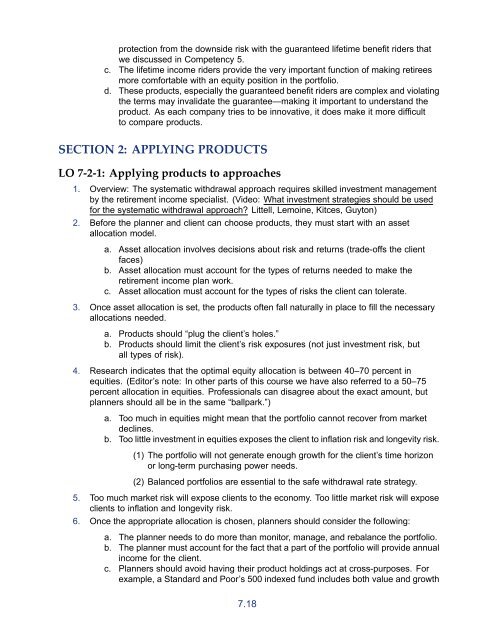section 1 - The American College Online Learning Center
section 1 - The American College Online Learning Center
section 1 - The American College Online Learning Center
You also want an ePaper? Increase the reach of your titles
YUMPU automatically turns print PDFs into web optimized ePapers that Google loves.
protection from the downside risk with the guaranteed lifetime benefit riders thatwe discussed in Competency 5.c. <strong>The</strong> lifetime income riders provide the very important function of making retireesmore comfortable with an equity position in the portfolio.d. <strong>The</strong>se products, especially the guaranteed benefit riders are complex and violatingthe terms may invalidate the guarantee—making it important to understand theproduct. As each company tries to be innovative, it does make it more difficultto compare products.SECTION 2: APPLYING PRODUCTSLO 7-2-1: Applying products to approaches1. Overview: <strong>The</strong> systematic withdrawal approach requires skilled investment managementby the retirement income specialist. (Video: What investment strategies should be usedfor the systematic withdrawal approach? Littell, Lemoine, Kitces, Guyton)2. Before the planner and client can choose products, they must start with an assetallocation model.a. Asset allocation involves decisions about risk and returns (trade-offs the clientfaces)b. Asset allocation must account for the types of returns needed to make theretirement income plan work.c. Asset allocation must account for the types of risks the client can tolerate.3. Once asset allocation is set, the products often fall naturally in place to fill the necessaryallocations needed.a. Products should “plug the client’s holes.”b. Products should limit the client’s risk exposures (not just investment risk, butall types of risk).4. Research indicates that the optimal equity allocation is between 40–70 percent inequities. (Editor’s note: In other parts of this course we have also referred to a 50–75percent allocation in equities. Professionals can disagree about the exact amount, butplanners should all be in the same “ballpark.”)a. Too much in equities might mean that the portfolio cannot recover from marketdeclines.b. Too little investment in equities exposes the client to inflation risk and longevity risk.(1) <strong>The</strong> portfolio will not generate enough growth for the client’s time horizonor long-term purchasing power needs.(2) Balanced portfolios are essential to the safe withdrawal rate strategy.5. Too much market risk will expose clients to the economy. Too little market risk will exposeclients to inflation and longevity risk.6. Once the appropriate allocation is chosen, planners should consider the following:a. <strong>The</strong> planner needs to do more than monitor, manage, and rebalance the portfolio.b. <strong>The</strong> planner must account for the fact that a part of the portfolio will provide annualincome for the client.c. Planners should avoid having their product holdings act at cross-purposes. Forexample, a Standard and Poor’s 500 indexed fund includes both value and growth7.18
















